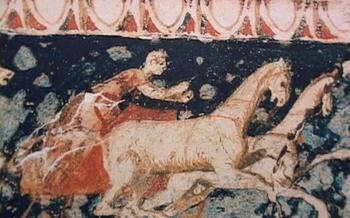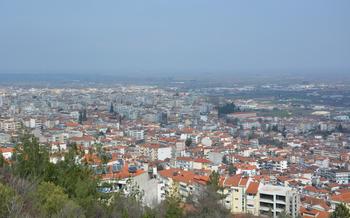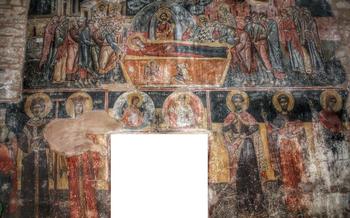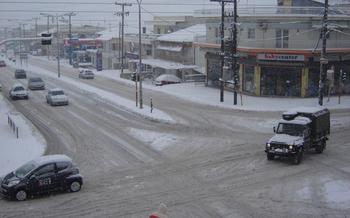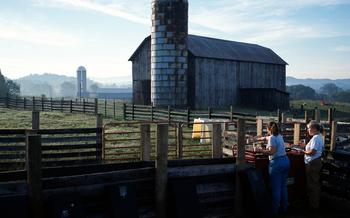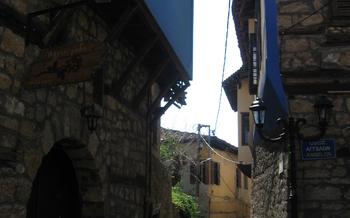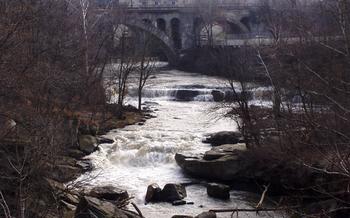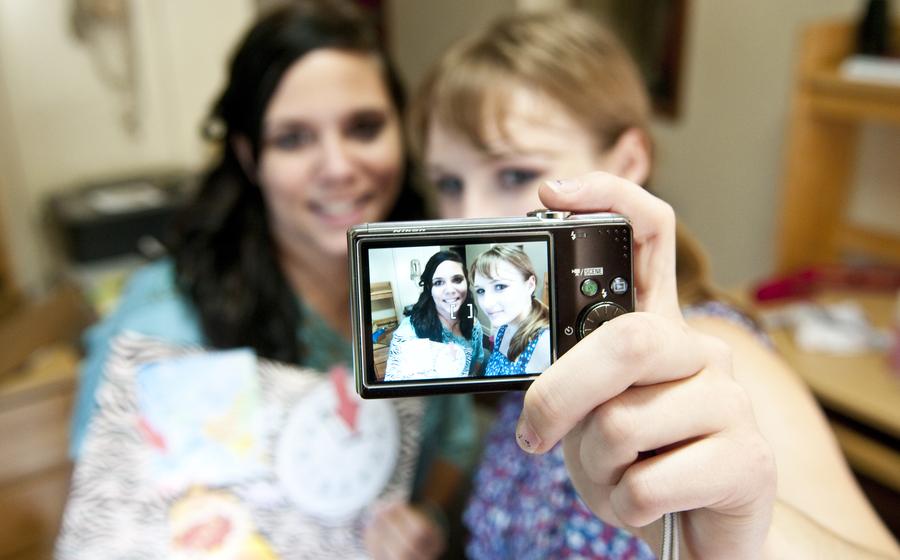
Nea Nikomedia Neolithic Settlement
- The Nea Nikomedia Neolithic Settlement: A Brief Overview
- Unveiling the History of Nea Nikomedia
- Exploring the Neolithic Village
- Admiring the Neolithic Artifacts
- Witnessing the Neolithic Burials
- Tracing the Legacy of Nea Nikomedia
- Planning Your Visit to Nea Nikomedia
- Tips for Exploring the Settlement
- Unleashing the Photographer Within
- Souvenirs to Remember Your Visit
- Enhancing Your Knowledge with Books and Films
- Promoting Responsible Tourism
- Engaging with the Local Community
- Extending Your Stay in Veria
- Insider Tip: Unveiling the Hidden Gem
The Nea Nikomedia Neolithic Settlement: A Brief Overview
The Nea Nikomedia Neolithic Settlement, located in the Imathia prefecture of Central Macedonia, Greece, stands as a testament to the ingenuity and resilience of our prehistoric ancestors. Dating back to the 7th millennium BC, this remarkable site offers a glimpse into the lives of the first farmers and herders of the region. As one of the earliest Neolithic settlements discovered in Greece, Nea Nikomedia holds immense significance for understanding the development of human civilization in the area.
With its well-preserved remains of houses, workshops, and burials, the settlement provides a unique opportunity to explore the origins of agriculture, animal domestication, and the emergence of sedentary communities. Visitors to Nea Nikomedia can marvel at the intricate Neolithic tools, pottery, and other artifacts that shed light on the daily lives and beliefs of these early inhabitants. Join us as we delve into the fascinating history and legacy of the Nea Nikomedia Neolithic Settlement, a true treasure trove of archaeological wonders.
Unveiling the History of Nea Nikomedia
The Nea Nikomedia Neolithic Settlement was founded around 6500 BC, making it one of the oldest known settlements in Greece. The Neolithic period, which lasted from around 10,000 BC to 3000 BC, was a time of great change and innovation, as humans transitioned from a hunter-gatherer to an agricultural lifestyle.
The Neolithic inhabitants of Nea Nikomedia were farmers and herders who lived in small, rectangular houses made of mudbrick and wood. They grew crops such as wheat, barley, and lentils, and raised animals such as sheep, goats, and cattle. They also made pottery, tools, and other artifacts from stone, bone, and antler.
Archaeological excavations at the site have revealed a wealth of information about the Neolithic people of Nea Nikomedia. These discoveries include the remains of houses, workshops, and storage pits, as well as a large number of tools, pottery, and other artifacts. The settlement also contains a number of burials, which have provided valuable insights into the beliefs and practices of the Neolithic people.
The Nea Nikomedia Neolithic Settlement is a significant site that has contributed greatly to our understanding of Neolithic Greece. It provides a glimpse into the lives of the people who lived in this region over 8,000 years ago, and helps us to understand how they adapted to the challenges of their environment and developed new technologies and ways of life.
Exploring the Neolithic Village
The Nea Nikomedia Neolithic Settlement offers a fascinating glimpse into the daily lives of the Neolithic people who inhabited this region over 7,000 years ago. The village consists of several different parts, including residential areas, workshops, and communal spaces.
The Neolithic people lived in small, rectangular houses made of mud-brick and wood. The houses were typically divided into two rooms, one for sleeping and one for cooking and storage. Each house had its own hearth, and some houses also had ovens.
The Neolithic people were primarily farmers and herders. They grew crops such as wheat, barley, and lentils, and they raised animals such as sheep, goats, and pigs. They also hunted wild animals and gathered wild plants.
The Neolithic people had a complex social organization. The village was led by a chief, who was responsible for making decisions and resolving disputes. The chief was assisted by a council of elders, who were the most experienced and respected members of the community.
Admiring the Neolithic Artifacts
The Nea Nikomedia Neolithic Settlement is a treasure trove of Neolithic artifacts, providing valuable insights into the daily lives of the settlement's inhabitants. Among the most remarkable finds are the stone tools, which showcase the ingenuity and craftsmanship of the Neolithic people. These tools, made from locally sourced materials such as flint and obsidian, served various purposes, including hunting, gathering, and food preparation.
The settlement has also yielded an impressive collection of pottery, ranging from simple utilitarian vessels to intricately decorated ceremonial pieces. The pottery features a variety of shapes and sizes, reflecting its diverse uses for storage, cooking, and serving food. The intricate designs and motifs on some of the pottery suggest that the Neolithic people had a keen eye for aesthetics and symbolism.
In addition to tools and pottery, the settlement has revealed a wealth of other artifacts, including bone tools, jewelry, and figurines. These objects provide glimpses into the Neolithic people's artistic expressions, technological advancements, and spiritual beliefs. The figurines, in particular, are of great interest as they offer clues about the religious practices and rituals of the Neolithic community.
These artifacts, meticulously preserved and displayed at the settlement's museum, offer a tangible connection to the past, allowing visitors to appreciate the ingenuity and creativity of the Neolithic people who once called Nea Nikomedia home.
Witnessing the Neolithic Burials
The Neolithic people of Nea Nikomedia had a unique set of burial practices that provide valuable insights into their beliefs and customs. Their dead were buried in communal graves, which were often located within the settlement itself. These graves were typically simple pits or trenches, and the bodies were buried in a flexed position, with their knees drawn up to their chests.
Grave goods were often included in the burials, suggesting that the Neolithic people believed in an afterlife. These goods included pottery vessels, tools, weapons, and jewelry. The presence of these objects suggests that the Neolithic people believed that the deceased would need these items in the next world.
The burials at Nea Nikomedia also provide evidence of social differentiation. Some graves contained more grave goods than others, suggesting that some individuals were more wealthy or held a higher status within the community. This social stratification is further supported by the fact that some of the graves were more elaborate than others.
Tracing the Legacy of Nea Nikomedia
The Nea Nikomedia Neolithic Settlement met its end around 5500 BC, marking the culmination of a vibrant era in human history. The reasons behind its demise remain shrouded in mystery, but it is believed that a combination of factors, such as climate change and overpopulation, may have played a role. The inhabitants of the settlement dispersed, leaving behind a rich legacy that would shape the course of Greek civilization.
The Nea Nikomedia Neolithic Settlement has had a profound impact on our understanding of Neolithic Greece. It has provided valuable insights into the daily lives, social organization, and economic activities of the Neolithic people. The artifacts unearthed at the site have shed light on their technological advancements, artistic expressions, and spiritual beliefs. The settlement has also contributed to our knowledge of the transition from a nomadic lifestyle to settled agriculture, a pivotal moment in human history.
Despite its significance, the preservation of the Nea Nikomedia Neolithic Settlement faces several challenges. The site is vulnerable to natural factors such as erosion and earthquakes, as well as human-induced threats such as looting and vandalism. The lack of resources and funding also poses a challenge to the effective conservation and management of the site.
Preserving the Nea Nikomedia Neolithic Settlement is crucial for safeguarding our cultural heritage and ensuring that future generations can appreciate and learn from this remarkable chapter in human history. Continued efforts are needed to protect the site, raise awareness of its importance, and promote sustainable tourism practices that contribute to its preservation. By working together, we can ensure that the legacy of Nea Nikomedia continues to inspire and educate for years to come.
Planning Your Visit to Nea Nikomedia
To make the most of your visit to the Nea Nikomedia Neolithic Settlement, careful planning is essential. The settlement is open to the public year-round, but the best time to visit is during the spring or fall when the weather is mild. To reach the settlement, you can take a bus or taxi from the city of Veria, which is located about 10 kilometers away.
Guided tours of the settlement are available, providing an in-depth look at the site's history and significance. These tours are led by experienced archaeologists who can answer your questions and share their knowledge. The settlement also offers various amenities, including a visitor center, a gift shop, and restrooms, to ensure a comfortable and educational experience for all visitors.
Tips for Exploring the Settlement
When exploring the Nea Nikomedia Neolithic Settlement, comfort and preparation are key. Wear comfortable shoes to navigate the uneven terrain, and bring water and snacks to stay hydrated and energized throughout your visit. The sun can be intense, so be sure to protect yourself with sunscreen, a hat, and sunglasses. Take your time to explore the site at your own pace, allowing yourself to fully immerse in the history and atmosphere of this ancient settlement. Embrace the opportunity to step back in time and connect with the lives of the Neolithic people who called this place home.
Unleashing the Photographer Within
The Nea Nikomedia Neolithic Settlement offers a treasure trove of photographic opportunities for visitors with a passion for capturing the beauty of the past. From the stunning views of the surrounding countryside to the well-preserved Neolithic houses, there are countless subjects waiting to be immortalized through the lens of a camera.
Get creative with your shots of the Neolithic artifacts, showcasing their intricate designs and craftsmanship. Share your photos on social media using the hashtag #NeaNikomedia to inspire others to explore this hidden gem of Greek history. Your images will not only document your visit but also contribute to raising awareness of this important archaeological site.
Souvenirs to Remember Your Visit
Preserve the memories of your visit to the Nea Nikomedia Neolithic Settlement by taking home unique souvenirs.
-
Visit the gift shop at the settlement to purchase replicas of Neolithic artifacts, such as pottery, tools, and jewelry. These replicas are not only beautiful but also educational, as they provide a tangible connection to the lives of the Neolithic people.
-
Explore the nearby villages and towns to find handmade crafts created by local artisans. These crafts often incorporate traditional techniques and designs, making them a wonderful way to support the local economy and take home a piece of Greek culture.
-
Consider purchasing souvenirs that are made from locally sourced materials, such as ceramics, textiles, or wood. This not only supports the local economy but also reduces the environmental impact of your souvenirs.
-
Share your love of the Nea Nikomedia Neolithic Settlement with friends and family by gifting them unique souvenirs. This is a thoughtful and meaningful way to spread awareness about this important archaeological site.
Enhancing Your Knowledge with Books and Films
To delve deeper into the fascinating world of the Nea Nikomedia Neolithic Settlement, immerse yourself in a rich collection of books and films that bring the Neolithic period to life. Discover the captivating narratives of archaeological discoveries, the intricate social dynamics of Neolithic communities, and the ingenious technologies that shaped their way of life.
Through the pages of well-researched books, let renowned historians and archaeologists guide you on a journey through time, unraveling the mysteries of the Neolithic era. Gain insights into the daily lives of the settlement's inhabitants, their beliefs and rituals, and the challenges they faced in a rapidly changing world.
Complement your reading experience with thought-provoking documentaries that transport you to the heart of the Neolithic period. Witness the meticulous excavations at Nea Nikomedia, hear from experts as they decipher the secrets hidden within the artifacts, and gain a deeper appreciation for the ingenuity and resilience of our Neolithic ancestors.
By immersing yourself in these literary and cinematic masterpieces, you'll enhance your understanding of the Nea Nikomedia Neolithic Settlement and the broader context of Neolithic Greece, leaving you with a profound appreciation for the legacy of this remarkable era.
Promoting Responsible Tourism
As responsible travelers, it is important to respect the Nea Nikomedia Neolithic Settlement and its surroundings. Dispose of your trash properly in designated bins to maintain the cleanliness of the site. Avoid touching or damaging the Neolithic artifacts, as they are invaluable pieces of history. By following these simple guidelines, you can help preserve this important archaeological site for future generations. Share your knowledge of the settlement with others to raise awareness about its significance. Encourage your friends and family to visit the site and learn about the Neolithic period in Greece. By promoting responsible tourism, you can help ensure that the Nea Nikomedia Neolithic Settlement remains a place of wonder and inspiration for all.
Engaging with the Local Community
Your journey to Nea Nikomedia offers a unique opportunity to connect with the vibrant local community. Embrace this chance to immerse yourself in the authentic culture of Veria. Venture beyond the Neolithic settlement and explore the neighboring villages and towns, each harboring its own charm and traditions. Strike up conversations with the friendly locals, eager to share stories of their heritage. Discover their way of life, their customs, and their deep-rooted connection to the land. Support the local economy by patronizing family-run shops, sampling the delectable cuisine at traditional tavernas, and purchasing handmade crafts from talented artisans. Your interactions with the local community will enrich your understanding of Veria's past and present, creating lasting memories that extend far beyond the Neolithic settlement.
Extending Your Stay in Veria
Veria, the city where the Nea Nikomedia Neolithic Settlement is located, offers a wealth of other attractions for visitors to explore. The Archaeological Museum of Veria houses a vast collection of artifacts from the Neolithic period to the Byzantine era, providing a comprehensive overview of the region's rich history. Visitors can also admire the stunning Byzantine churches that dot the city, such as the Church of the Holy Apostles and the Church of the Panagia Gorgoepikoos.
Beyond its historical and cultural attractions, Veria is surrounded by breathtaking natural beauty. The Vermio Mountains, with their lush forests and picturesque villages, offer ample opportunities for hiking, biking, and other outdoor activities. The Aliakmonas River, which flows through the region, is a popular spot for swimming, fishing, and kayaking.
For those seeking a deeper immersion into the local culture, Veria offers a vibrant culinary scene, with traditional Greek tavernas serving up delicious dishes made with fresh, local ingredients. Visitors can also explore the city's vibrant markets, where they can find everything from fresh produce to handmade crafts.
Whether you're a history buff, nature lover, or foodie, Veria has something to offer everyone. Extend your stay in this charming city to discover all its hidden gems and create lasting memories.
Insider Tip: Unveiling the Hidden Gem
To fully immerse yourself in the Neolithic experience, plan your visit to the Nea Nikomedia Neolithic Settlement during the annual festival held in the summer. This vibrant celebration brings the ancient world to life with traditional Greek music, dance, and food. Immerse yourself in the lively atmosphere as you witness locals dressed in Neolithic attire, showcasing their rich cultural heritage.
Participate in interactive exhibits and demonstrations that provide hands-on experiences, allowing you to learn about the daily lives of the Neolithic people. Discover how they crafted tools, made pottery, and engaged in various activities that shaped their community.
The festival offers a unique opportunity to connect with the past and gain a deeper appreciation for the ingenuity and resilience of the Neolithic people. Don't miss this chance to experience the Nea Nikomedia Neolithic Settlement in all its glory, while also immersing yourself in the vibrant culture of modern Greece.
